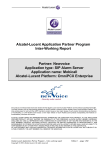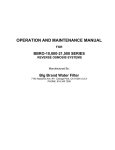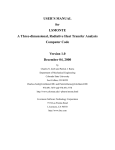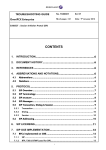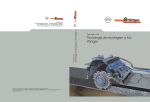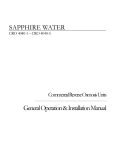Download 1-D-Coupled Model User`s Manual
Transcript
One Dimensional Coupled Model
User's Manual
Prepared By:
Arastoo P. Biazar
Atmospheric Science Program
University of Alabama in Huntsville
Huntsville, Alabama
January 13, 1994
February 17, 2009
1
Section I:
PROGRAM DESCRIPTION
What follows is the description of the main program routine, the subroutines that
it calls and their main function, and model requirements in general.
Main routine:
The main routine is called "UAH1DMDL" and it consists of calls to 16 different
subroutines. The main function of the first 15 subroutines is to provide the necessary
input parameters and to do preparation for the model run. The 16th. subroutine called
"UAHMDL" is the main body of the model and will do the required simulation.
Subroutine names and arguments are:
SETUP ...................................opens the i/o files and library file
STAMP(ISTAMP).................prints out the current date and time to the unit ISTAMP
RDINPT(XTIME)..................reads title and gear parameters
RDSPEC ................................reads optional list of species to define order in printout
RDREAC ...............................reads reaction specifications, optional rate constants
RDRKA..................................reads reaction rate constants (from the input file)
RDSOLAR.............................reads photolysis rate constants
RDCCON...............................reads species whose concentrations are constant
RDNDIS.................................not used, (read species not subject to dispersion)
RDDISP .................................not used, (read species subject to dispersion)
REORDR ...............................reorders species list
RDNAMES ............................reads in the name of the files - met and flux data update
files
RDFLUXA.............................reads species with flux at the boundary
RDFLUXB.............................reads species with deposition velocity at the boundary
RDFLUXC.............................reads species with flux contribution to all levels
UAHMDL(XTIME)...............solves equations by gear method
A description of each of these subroutines will follow.
Subroutine SETUP:
This subroutine is the only interactive part of the program. The inputs can either
be typed in at the terminal, if the program is running interactively, or can be furnished in
a file assigned to the standard input unit (i.e., unit 5). This routine requires the answers
to three questions regarding debug option, input/output file names, and the reaction
library file name. The three lines of input that satisfies this routine are:
Line 1:
The user is prompted for the DEBUG option. The answer can be either
"y" for "yes" or "n" for "no". If the answer is "yes", then the debug option
will be turned on and the model output will be dumped to the screen. If
February 17, 2009
2
the answer is "no", then the debug option will be turned off and the output
delivered to the output file.
Line 2:
The user is prompted for the input/output filename. The name that user
supplies here (with no extension) will be used for both input and output
files with different extensions. Three files will be opened:
File 1: an input file with an extension of "IN".
File 2: an output file with an extension of "OUT".
File 3: an output file with an extension of "EQT".
For example if user supplies the name "TEST", then a file named
"TEST.IN" will be opened as input file and must contain all the required
input parameters. A file named "TEST.OUT" will be opened to deliver
the output information. This file will contain specific information about
the simulation. The third file to be opened is called "TEST.EQT" which is
an output file and will contain the concentration values at equal time
periods.
Line 3:
The user is prompted for the reaction library filename. This name should
be the complete filename. This file is an input file and must be supplied
by the user. This file contains some of the Gear parameters plus a
complete list of the reactions and their type and reaction rate constants.
We will refer to this file as the permanent library file.
Subroutine RDINPT(XTIME):
This subroutine reads in the title of the run and other input parameters from both
input files (i.e., parameter input file and permanent library file). Description of each will
follow in the section describing the input/output files.
Subroutine RDSPEC:
This subroutine reads optional list of species from the parameter input file to
define order in printout. Species names must be in exact form and spelling as they appear
in the permanent library file. The names are separated by a space between them. Each
line can contain as many names as the user wishes to write.
Subroutine RDREAC:
February 17, 2009
3
This subroutine reads reaction specifications. The subroutine first reads the
reaction labels from parameter input file. These are the reactions that user wishes to
include in the simulation. Then the permanent reaction library is searched for the
reaction lists with these labels. If they are found they will be included in the simulation
otherwise an error message will be displayed. By inclusion we mean that the subroutine
RDREAC reads the complete list of the reaction. This include the reactants and the
products of the reaction and rate constants or the parameters necessary to calculate the
rate constants. Subroutine CALCR calculates the rate constants that need to be
calculated every update time.
Subroutine RDRKA:
This subroutine reads reaction rate constants (from the parameter input file). It
reads reaction labels followed by a reaction rate constant. This option allows the user
specify reaction rate constants different from that of the permanent library.
Subroutine RDSOLAR:
This subroutine reads the time profile of the photolysis rates from the file called
SOLARTC.IN. Photolysis rate constants are read only once at the beginning of the
simulation and stored in an array called SRATE. Then each update interval subroutine
UPDATE6 updates the rate constants by interpolation.
Subroutine RDCCON:
This subroutine reads species whose concentrations are constant during the course
of the simulation. This means that a differential equation regarding the chemical reaction
of these species will not be set but they will be treated for vertical diffusion and transport.
They also will be updated if necessary.
Subroutine RDNDIS:
This subroutine is here for historical reason. It may be used later.
February 17, 2009
4
Subroutine RDDIS:
This subroutine is here for historical reason. It may be used later.
Subroutine REORDR:
This subroutine reorders the species array so that the species with the constant
concentration will be moved to the end of the array. This is useful since it adds to the
efficiency of the model when solving for stiff differential equations.
Subroutine RDNAMES:
This subroutine reads the name of the files containing the time series of
meteorological data and boundary and incoming flux data. The first file contains the
meteorological data. The second file contains the boundary fluxes, species deposition
velocities, and flux of the pollutants at different vertical levels.
Subroutine RDFLUXA:
This subroutine reads species with a flux at the boundary from the parameter
input file. The name and order of the species here must match the data in the chemistry
update file. The flux unit right now is "(#/CM**3).CM/S" which can easily be changed
to "PPM.CM/S" by a little modification to the code.
Subroutine RDFLUXB:
This subroutine reads species with a deposition velocity at the boundary from the
parameter input file. The name and the order of the species should match that of the
chemistry update file. The unit is cm/s.
February 17, 2009
5
Subroutine RDFLUXC:
This subroutine reads the name of the species with an incoming flux between two
vertical levels in the model. The name and the order of the species should match that of
the chemistry update file. The two vertical levels are also included in the update file.
Subroutine UAHMDL:
This subroutine is the main body of the model. It integrate the model equations
and will terminate after the time period specified by the user.
February 17, 2009
6
Section II:
DESCRIPTION OF THE INPUT AND OUTPUT FILES
There are eight input files used by this model and three output files created by the
model. These files are:
(A) Input files:
1) Interactive input file
2) Control parameter input file
3) Permanent library file
4) Meteorological data file
5) Chemistry data file
6) Photolysis rate constants file -- solar file
7) Initialization file -- initial concentration data file
8) Restart binary data file
(B) Output files:
1) Information output file
2) Concentration output file
3) Restart binary data file -- End of the run concentration file
1) Interactive input file:
This an optional file. The information requested by the model interactively can
be provided in several ways. One way to furnish the required information is to write
them into a file and then assign this file to be the standard input unit. The format of this
file is:
Line 1: Either "y" or "n" for the answer to debug option
Line 2: Name of the control parameter input line
Line 3: Name of the permanent library file
2) Control parameter input file
The name of this file is given to the program interactively. This file contains the
definition of the input parameters for 1d-coupled model. The contents of the file are as
follows:
LINE #1:
VARIABLE NAME:
VARIABLE TYPE:
USAGE:
February 17, 2009
TITLE
REAL*8
TITLE(10)
COMMON/GEAR/TITLE
An array of 10 containing the title for the run
7
LINE #2:
VARIABLE NAME:
VARIABLE TYPE:
USAGE:
LINE #3:
VARIABLE NAME:
VARIABLE TYPE:
USAGE:
LINE #4:
VARIABLE NAME:
VARIABLE TYPE:
USAGE:
TMAX
REAL*8
TMAX
COMMON/GEAR/TMAX
Simulation time in hours. After read statement it is
converted to seconds. TMAX = TMAX*3600.
XEQT
REAL XEQT
LOCAL TO SUBROUTINE RDINPT
Number of species to be printed at equal time
intervals in ".EQT" file.
NEQT = INTEGER(XEQT)
COMMON/GEAR/NEQT
IRESTART
INTEGER
IRESTART
COMMON/RDINPT/IRESTART
Indicates how the model to be initialized.
IRESTART = 0
->
Not a restart
IRESTART = 1
->
Restart with one file
IRESTART = 2
->
Restart with two files
If IRESTART=0 then model reads the initial values from a file
supplied by the user.
If IRESTART=1 then model reads the initial values from a file
called 'TCRESTART.BIN' which is a binary file created by the
model at the end of each run.
If IRESTART=2 then model first reads the initial values from
'TCRESTART.BIN' file and then reads other values from a file
supplied by the user. Content of this file can be a modification of
the concentration values or some other new values not presented in
'TCRESTART.BIN' file.
LINE #5:
VARIABLE NAME:
VARIABLE TYPE:
USAGE:
February 17, 2009
RUNTYPE
INTEGER
RUNTYPE
COMMON/UAHGEAR/RUNTYPE
Indicates the type of experiment.
RUNTYPE = 1
->
DISPERSION+CHEM.
REAC.
RUNTYPE = 2
->
CHEM. REAC. ONLY
RUNTYPE = 3
->
DISPERSION ONLY
8
If RUNTYPE=1 then both chemical reactions and dispersion are
being considered and the full model is implemented.
If RUNTYPE=2 only chemical reactions are being considered and
the dispersion mechanism is turned off.
If RUNTYPE=3 only dispersion is being considered and the
chemical reactions mechanism is turned off.
LINE #6:
VARIABLE NAME:
VARIABLE TYPE:
USAGE:
TVFLAG
LOGICAL
TVFLAG
TVFLAG determines if temperature varies during
the run or it is a constant.
If TVFLAG=.TRUE. then temperature profile is being updated
every update time (TUPDATE time interval).
If TVFLAG=.FALSE. then temperature profile is set to a constant
value and the next line in the input file must be the constant
temperature value.
LINE #7:
VARIABLE NAME:
VARIABLE TYPE:
USAGE:
PVFLAG
LOGICAL
PVFLAG
PVFLAG determines if pressure varies during the
run or it is a constant.
If PVFLAG=.TRUE. then pressure profile is being updated every
update time (TUPDATE time interval).
If PVFLAG=.FALSE. then pressure profile is set to a constant
value and the next line in the input file must be the constant
pressure value.
LINE #8:
VARIABLE NAME:
VARIABLE TYPE:
USAGE:
IUPDATE
INTEGER
IUPDATE
IUPDATE is the update indicator, it determines the
value of logical name NOUPDATE
If IUPDATE=0 then NOUPDATE=.TRUE. and the subroutine
UPDATE is bypassed.
If IUPDATE=1 then NOUPDATE=.FALSE. and the subroutine
UPDATE is being called every TUPDATE time interval.
LINE #9:
February 17, 2009
9
VARIABLE NAME:
VARIABLE TYPE:
USAGE:
TUPDATE
REAL*8
TUPDATE
Time interval for updating the variable data; such as
pressure, temperature and boundary fluxes.
LINE #10...to the END-OF-FILE:
From here to the end of the file inputs are in a block format. Each block starts
with a comment line followed by as many line of input as necessary. The block
ends with the symbol "*END" in a separate line by itself indicating the end of the
data. A block with only the comment line followed by a line with "*END" means
that the block does not contain any data. Blocks are as follows:
BLOCK #1:
This block contains the name of the species to be printed. Species names
must be in exact form and spelling as they appear in the permanent library
file. The names are separated by a space between them. Each line can
contain as many names as the user wishes to write. Subroutine
"RDSPEC" reads this block.
BLOCK #2:
This block contains the reaction labels. Only the reactions with these
labels will be included in the simulation. The program reads the
permanent reaction library and includes the reactions with matching
labels. The labels here must be in exact form as they appear in the
permanent library. Subroutine "RDREAC" reads this block.
BLOCK #3:
This block contains the list of reaction labels followed by a reaction rate
constant. This block is used if there are reactions with rate constants
different from that of the permanent library. Subroutine "RDRKA" reads
this block.
BLOCK #4:
This block contains the name of species which have constant
concentration during the simulation. This means that a differential
equation regarding the chemical reaction of these species will not be set.
But they will be treated for vertical diffusion and transport. They also will
be updated if necessary. Subroutine "RDCCON" reads this block.
BLOCK #5:
This block is here for historical reasons. It may be used later. Subroutine
"RDNDIS" reads this block.
BLOCK #6:
This block is here for historical reasons. It may be used later. Subroutine
"RDDIS" reads this block.
BLOCK #7:
February 17, 2009
10
This block contains the name of the files containing the time series of
meteorological data and boundary and incoming flux data. The first line
of this block starts with integer number "1" followed by a space and the
name of the file containing the meteorological data. The second line starts
with integer number "2" followed by a space and the name of the file
containing the boundary fluxes, species deposition velocities, and flux of
the pollutants at different vertical levels. Subroutine "RDNAMES" reads
this block.
BLOCK # 8:
This block contains the name of the species with boundary flux. The
name and order of the species here must match the data in the chemistry
update file. The flux unit right now is "(#/CM**3).CM/S" which can
easily be changed to "PPM.CM/S" by a little modification to the code.
Subroutine "RDFLUXA" reads this block.
BLOCK #9:
This block contains the name of the species with deposition velocity at the
boundary. The name and the order of the species should match that of the
chemistry update file. The unit is CM/S. Subroutine "RDFLUXB" reads
this block.
BLOCK #10:
This block contains the name of the species with an incoming flux
between two vertical levels in the model. The name and the order of the
species should match that of the chemistry update file. The two vertical
levels are also included in the update file.
BLOCK #11:
This block contains the name of the file containing the species initial
values for all the grids in the model.
3) Permanent Reaction library input file
The name of this file is given to the program interactively. The permanent
reaction library input file contains some of the control
parameters for the Gear solver and a complete list of the reactions and
factors used in calculations of reaction rate constants. The following is the
line by line description of the contents of this file.
Line 1:
VARIABLE NAME:
VARIABLE TYPE:
February 17, 2009
EPS
REAL*8
EPS
11
USAGE:
Tolerance for convergence in the Gear routine.
This tolerance can be changed internally in Gear if
the convergence is not achieved within the specified
iteration limit.
VARIABLE NAME:
VARIABLE TYPE:
USAGE:
HMIN
REAL*8
HMIN
Minimum time step allowed in the integration.
Time step in the Gear routine cannot be reduced to
a value less than HMIN. If this value is reached,
the program will terminate with an error message.
VARIABLE NAME:
VARIABLE TYPE:
USAGE:
HMAX
REAL*8
HMAX
Maximum integration time step to be taken in the
simulation.
VARIABLE NAME:
VARIABLE TYPE:
USAGE:
NOUT
INTEGER
NOUT
Number of species in the output. The concentration
of the first NOUT members of the species list will
be printed in the "*.DAT" file.
VARIABLE NAME:
VARIABLE TYPE:
USAGE:
NTEST
INTEGER
NTEST
For historical reasons.
VARIABLE NAME:
VARIABLE TYPE:
USAGE:
NWRPLO
INTEGER
NWRPLO
For historical reasons.
VARIABLE NAME:
VARIABLE TYPE:
USAGE:
MF
INTEGER
MF
Method indicator for Gear routine. This variable
indicates what method to be used in Gear routine.
Notice that we use a variable order multi-step
method. This means the order of the method
(number of steps in the multi-step method) changes
internally to achieve the required accuracy.
Line 2:
Line 3:
Line 4:
Line 5:
Line 6:
Line 7:
MF
February 17, 2009
METHOD USED
12
0
An ADAMS Predictor-Corrector is used. ADAMS method
is a multistep method. It can be both implicit and explicit.
If the implicit method is used to improve the approximation
obtained by an explicit method, the combination is called
"Predictor-Corrector" method. Thus with choice of MF=0,
the ADAMS explicit method is used to predict the
approximation, then ADAMS implicit method is used to
correct it.
1
A multi-step method suitable for stiff system is used. It
will also work for non-stiff systems. However the user
must provide a subroutine "PEDERV" which evaluates the
partial derivatives of the differential equations with respect
to
the
YC's.
This
is
done
by
call
PEDERV(XTIME,YC,PW,M). Where PW is an N by N
working array which must be set to the partial of the i-th
equation with respect to the j-th dependent variable in
PW(i,j). PW is actually an M by M array, where M is the
value of N used on the first call to DIFSUB.
2
The same as case I, except that this subroutine computes
the partial derivatives by numerical differencing of the
derivatives. Hence PEDERV is not called.
Line 8:
VARIABLE NAME:
VARIABLE TYPE:
USAGE:
NLARGE
INTEGER
NLARGE
This parameter indicates the method of matrix
inversion for the matrix of partial derivatives.
If NLARGE=0 then the inverse of matrix is found
directly (if non-singular).
If NLARGE is not zero then the program performs
L/U decomposition on matrix of partial derivatives.
VARIABLE NAME:
VARIABLE TYPE:
USAGE:
TINC
REAL*8
TINC
This parameter indicates the TINC is the output
time interval (in hrs).
Line 9:
Line 10 through the end of the file:
Line 10 contains the comment line. Following this comment line, each line
contains a reaction label followed by the reaction list, type of the reaction, and
necessary parameters for calculating the rate constants. There are several states in
reading the reaction list. The first state is when the reaction label is being read. It
is checked against the list of reaction labels and an error message is printed if a
match is not found, i.e., it is an undefined reaction label.
February 17, 2009
13
The second state is reading reactants. Reactants are read until an '=' is
encountered. '+'s, which separate reactants, are optional and ignored.
The third state is reading products. '+'s are ignored.
The products are followed by a ';', which indicates the start of the fourth state. In
the fourth state the program reads the type of rate constant and from that
determines how many more variables to read for that type of rate constant
calculation. It then reads that many variables and puts them into the array
RKMOD. Then the program reads the order of the reaction (i.e., 1 for first order
reactions, 2 for 2nd. order reactions and so forth).
The fifth state occurs when a '000'O occurs, which means the end of the data line
has been reached - the next line is read.
Rate constants for each type is calculated in the following way:
CASE #1
Reactions that are dependent on solar intensity. Rate constant calculated
elsewhere and are inputted from SOLARTC.IN file.
CASE #2
Reactions which have constant rate constants. Read 1 subsequent number;
that is the rate constant.
CASE #3
Reactions which are temperature dependent. Need 2 subsequent numbers;
1st one is A (pre-exponential factor) 2nd one is E (activation energy).
The calculation is according to the ARRHENIUS EQUATION:
K = A*exp(-E/RT)
CASE #4
Pressure-dependent reactions (set of 5 with common equation).
Need 4 subsequent numbers:
1ST = KO(300), 2ND = N, 3RD = KI(300), 4TH = M
KA = KO300
KB = N
KC = KI300
KD = M
−N
300 ⎛ T ⎞
KO(T ) = KO ∗⎝
300 ⎠
−M
300 ⎛ T ⎞
KI(T ) = KI ∗
⎝ 300 ⎠
February 17, 2009
14
⎡
⎤
−1
⎛ KO(T )∗PRES ⎞ ⎤ 2 ⎪⎫
⎪⎧ ⎡
⎟⎟ ⎥ ⎬
⎨ 1+ ⎢ Log10 ⎜⎜
⎢
⎢ KO(T )∗PRES ⎥
KI (T )
⎝
⎠ ⎥⎦ ⎭⎪
⎩⎪ ⎣
K=⎢
∗0.6
⎥
⎛⎜ KO(T )∗ PRES ⎞
1
+
⎢⎣ ⎝
⎠ ⎥⎦
KI(T)
CASE #5
These are unimolecular reactions.
Read 3 subsequent numbers:
1ST = number of reaction that this is the reverse of
2ND = A, 3RD = B
K = KR∗A∗e
⎛ − B⎞
⎜
⎟
⎝ T ⎠
where
⎡
⎤
−1
⎛ KO(T )∗PRES ⎞ ⎤ 2 ⎪⎫
⎪⎧ ⎡
⎟⎟ ⎥ ⎬
⎨1+ ⎢ Log10 ⎜⎜
⎢ KO(T )∗PRES ⎥
KI (T )
⎪⎩ ⎢⎣
⎝
⎠ ⎥⎦ ⎪⎭
KR =
∗0.6
⎢ ⎛⎜ KO(T )∗PRES ⎞ ⎥
1+
⎢⎣ ⎝
⎠ ⎥⎦
KI(T )
and
− BB
⎛ T ⎞
⎝ 300 ⎠
− DD
⎛ T ⎞
KI( T ) = CC∗ ⎝
300 ⎠
KO(T ) = AA∗
The values of AA, BB, CC and DD depend on the value of the first input
parameter. We let the first parameter to be named NREV. Then:
NREV = 20 ⇒
{
AA =1. 8×10−31
BB=3 .2
CC=4 .7 ×10 −12
DD =1. 4
and
AA =2. 2×10−30
=4.3
NREV = 22 ⇒ ⎧⎨ BB
×10 −12
⎩ CC=1.5
DD =0. 5
CASE #6
Special CASE #1.
Individual calculation for
O3P + O2 --> O3
February 17, 2009
15
−2.3
⎛ T ⎞
K = [PRES]∗6.0∗10 ∗ ⎝
300 ⎠
−34
CASE #7
Special CASE #2
Individual calculation for
HO2 + HO2 --> H2O2
K = 2.2∗10
−13
∗e
⎛ 620 ⎞
⎜
⎟
⎝ T ⎠
+ 1.9∗10
−33
⎛ 980 ⎞
⎜
⎟
⎝ T ⎠
∗[PRES ]∗e
CASE #8
Special CASE #3
Individual calculation for
HO2 + HO2 + H2O --> H2O2
K = 3.08∗10
−34
⎛ 2820 ⎞
⎜
⎟
⎝ T ⎠
∗e
+ 2.66∗10
−54
⎛ 3180 ⎞
⎜
⎟
⎝ T ⎠
∗[PRES ]∗e
CASE #9
Special CASE #4
Individual calculation for
HO + HNO3 -> NO3 + H2O
KO=7.2E-15*EXP(785./T)
K2=4.1E-16*EXP(1440./T)
K3=1.9E-33*EXP(725./T)*PRES
K = KO + K3/(1+ K3/K2)
CASE #10
Special CASE #5
Individual calculation for
CO + HO -> HO2 + CO2
K=1.5E-13 * (1. + 2.439E-20 * PRES)
CASE #11
Special CASE #6
Individual calculation for
HO + HO2 -->
K = 1.7∗10
February 17, 2009
−11
∗e
⎛ 416 ⎞
⎜
⎟
⎝ TA ⎠
+ 3.0∗10
−31
⎛ 500 ⎞
⎜
⎟
⎝ TA ⎠
∗[PRES ]∗e
16
4) Meteorological data file
This file contains the necessary meteorological data. This file is created by
running the Mesoscale Boundary Layer in 1_D mode. The contents of this file are as
follows:
Line 1:
Number of vertical grid points KZ, followed by the delta-t (time increment
used in mesoscale model). These values are read only once by subroutine
INITDIF.
Line 2...through line 2+KZ:
The height of the vertical levels. The heights are in centimeter (CM).
Line KZ+2+1:
Time of the output. This is the mesoscale model simulation time in
minutes.
Line KZ+2+2:
USTAR, PHISTAR, and ROOF.
USTAR is the friction velocity in CM/S.
PHISTAR another friction quantity which is not being used at the present
time.
ROOF is the planetary boundary layer height in CM.
Line KZ+2+3 ... through KZ+2+3+KZ:
Each of the following lines contains THETAP, PIP, QVP, and ALPHA for
each vertical grid point.
THETAP is the potential temperature in degrees Kelvin, it will be
converted to temperature by the function THETATOT.
Since potential temperature is calculated according to Poisson's equation:
THETA = T * (P0/P)**(R/CP)
thus T = THETA * (P/P0)**(R/CP)
Units of input must be as follows:
THETA:
IN DEGREES K
P:
IN MILIBARS
Units of output is as follows:
THETATOT: In degrees Kelvin
Constants used:
P0 = 1000. MILIBARS
CP = 1.005E+03 J/(KG K)
= 1.005E+07 CM**2/(S**2 K)
RD = 287 J/(KG K)
RD/CP = .286
Therefore the equation for the conversion will be:
T = THETA * (P/1000.)**0.286
February 17, 2009
17
PIP is scaled pressure (PI) use the EXNER function to get the unscaled
pressure in MILIBARS:
P = P0 * (PIP/(CP*10000.))**(CP/RD)
WHERE
CP = 1004. M**2/(S**2 . K)
CP/RD = 3.4965
P0 = 1013.25 MB
and 10000. is the unit correction factor for M**2 to CM**2
QVP is specific humidity (MVAPOR/MMOIST-AIR) IN G/G
ALPHA is the diffusion coefficient in CM**2/S
The last KZ+2 line of this file will be repeated. When it is time to update the
meteorological data this file is being read again to update the values.
5) Chemistry data file
This file contains the information about the chemical species and their fluxes.
The file can be created with the help of a preprocessor. The preprocessor program is
called "CHEMBLD.for". The chemistry data file contains 1) the flux of species at the
boundary, 2) the deposition velocities, and 3) flux of the species between levels 1 and 2
of the model. Each of these three elements can be and must omitted according to the
specification in the parameter-input file. For example if there is no species with
incoming flux between two model levels, the control parameter data file does not have
any entry in the corresponding section. Thus, chemistry data file also should not contain
any entry. In another word, control parameter data file contains the list of the species
whose values are read from chemistry data file. For the same reason the order of the
values in the chemistry data file must match the order of the species list in the control
parameter data file. The elements of the chemistry data file are as follows:
1)
A.
B.
A HEADER LINE FOR SPECIES WITH FLUXES AT THE
BOUNDARY
VALUE OF THE FLUX IN ((#/CM**3).(CM/S))
2)
A.
B.
A HEADER LINE FOR DEPOSITION VELOCITIES
VALUES IN (CM/S)
3)
A.
A HEADER LINE FOR SPECIES WITH FLUX TO THE
LEVELS 1 TO 2
VALUES IN ((#/CM**3)/S)
B.
The number of entries (lines) for each block depends on the number of species
specified in the control parameter data file.
February 17, 2009
18
6) Photolysis rate constants file -- solar file
This file contains the time profile of the photolysis rate constants. At the present
time the file is called "SOLARTC.IN" and can be created by running the program
"SOLAR.FOR". Program SOLAR calculates the photolysis rate constants for different
species according to the geographical area and time of the day by calculating the solar
radiation intensity for a given point in space and time and using a table of quantum yields
for species.
The content of the file SOLARTC.IN is:
Line 1: Comment line
Line 2: Starting time, Ending time, Time increment.
Starting local time is in 2400 format. Ending time is also in 2400 format
except that this is the accumulated time, thus for a four day simulation (96
Hrs) the Starting time is 600 and the Ending time is 10200. Time
increment is in minutes.
Line 3...
From line 3 to the end of the file the same format for each of the species
will follow.
The header line contains the reaction label and the name of the species in
the same form as in the permanent reaction library.
The header line is followed by several lines of data.
Each of these lines have three elements, the Time, solar zenith angle, and
the photochemical reaction first order rate constant for the species in the
header line at the time indicated. The unit for the rate constant is 1/Sec.
7) Initialization file -- initial concentration data file
This file contains the initial values for species concentrations. This file is an
ASCII file and be created with a text editor. The first line of this file is a comment line.
Each of the following blocks have the name of the species in a separate line followed by
the species initial concentration for each grid point (starting with grid point 1 at the
lowest model level). This file sometimes is used in conjunction with TCRESTART.BIN
file which is a binary file created by the model at the end of each run.
8) Restart binary data file
We can use the restart binary file to restart the model from the point that model
was last terminated. We can also change some of the concentration values when
restarting the model. Model automatically creates this binary file at the end of each
simulation. This binary file that at the present time is called "TCRESTART.BIN" is
optional and it is used if IRESTART is 1 or 2.
February 17, 2009
19



















